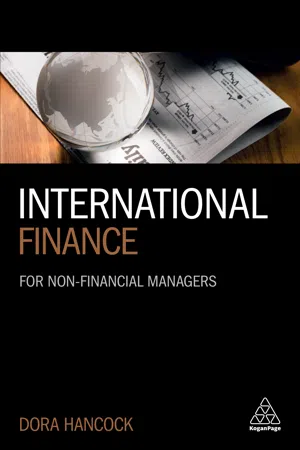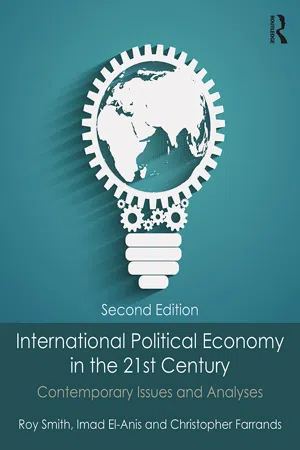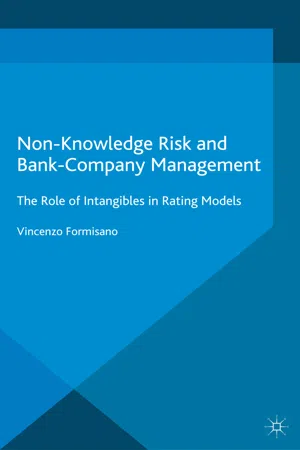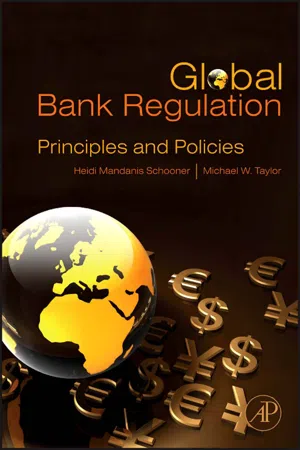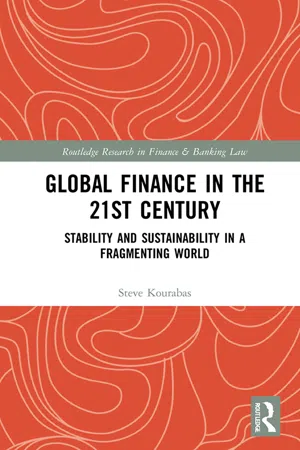Economics
Global Financial System
The global financial system refers to the network of institutions, markets, and mechanisms that facilitate the flow of funds and capital across the world. It encompasses financial institutions such as banks, stock exchanges, and regulatory bodies, as well as the various financial instruments and currencies that are traded internationally. The global financial system plays a crucial role in supporting economic activities and facilitating international trade and investment.
Written by Perlego with AI-assistance
Related key terms
10 Key excerpts on "Global Financial System"
- eBook - ePub
International Finance
For Non-Financial Managers
- Dora Hancock(Author)
- 2018(Publication Date)
- Kogan Page(Publisher)
02The institutions and participants that make up the Global Financial System
At the end of this chapter you will be able to:- identify and discuss the participants in the Global Financial System, particularly the role of central banks;
- discuss the need for banking regulation and supervision and the difficulties faced by legislators;
- briefly describe what happened in the global financial crisis.
Introduction
The Financial Times defines the Global Financial System as:This is the interplay of financial companies, regulators and institutions operating on a supranational level. The Global Financial System can be divided into regulated entities (international banks and insurance companies), regulators, supervisors and institutions like the European Central Bank or the International Monetary Fund. The system also includes the lightly regulated or non-regulated bodies – this is known as the ‘shadow banking’ system. Mainly, this covers hedge funds, private equity and bank-sponsored entities such as off-balance-sheet vehicles that banks use to invest in the financial markets.The Global Financial System has grown over recent decades to meet the needs initially of international trade, and today to meet the complex needs of companies, investors, governments, banks and everyone seeking to borrow or invest money or to use a currency other than their domestic currency.One way or another almost all of us have some contact with the Global Financial System. Holidaymakers will be affected by changes in exchange rates, finding their holiday more or less expensive than in previous years. Oil and fuel are priced in dollars so the fall in the value of sterling following the Brexit vote led to an increase in fuel prices across the UK. In practice, there are also links between the interest rates that different countries charge and this impacts on the cost of borrowing for most of us. - eBook - ePub
International Political Economy in the 21st Century
Contemporary Issues and Analyses
- Roy Smith, Imad El-Anis, Christopher Farrands(Authors)
- 2017(Publication Date)
- Routledge(Publisher)
7 Global finance
After reading this chapter, students should be able to:Chapter learning outcomes■ Understand what makes up the Global Financial System, and how it operates, including explaining key terms and vocabulary relating to it.■ Have a sound basic understanding of the history of the development of the Global Financial System, and of why finance is central to all activity in IPE.■ Be able to explain how the institutions and regulation of global finance have changed, and with what effects, before and after 2008.■ Understand the arguments about the main causes of the global financial breakdown in 2007–2010, and be able to debate the relative merits of at least two explanations of the crisis.■ Have a clear sense of why the Global Financial System is of such importance to all governments and why the major states in the global system have found it impossible to leave the management of the financial system to markets or banks.■ Have an understanding of how and why the Global Financial System has recovered from the crisis of the 2000s, and the current issues and problems it now faces.IntroductionThe Global Financial System is at once (i) a market in which money itself, and financial products, representing credit, debt and risk, are bought and sold; (ii) a structure of exchange, what accountants would call a pattern of flows of funds, in which first Britain, then the US, then Japan, and most recently China has acted as the dominant provider of funds for the major debtor nations and firms; and (iii) a set of institutional arrangements, including regulators and rules and institutional procedures, most obviously exemplified in recent years by the continuing rise of the G20 bloc of leading developed and developing nations along with global institutions and key market actors who, it could be said, both largely caused the 2007–2009 crisis and enjoyed success (so far) in resolving it. It is also a system of power that distributes gains, losses and the prospects of future gains and losses in a number of different forms. - Maureen Burton, Reynold F. Nesiba, Bruce Brown(Authors)
- 2015(Publication Date)
- Routledge(Publisher)
Part 7 The International Financial System- The International Financial System
- Monetary Policy in a Globalized Financial System
Passage contains an image
Chapter Twenty-Five 25 The International Financial System
DOI: 10.4324/9781315706405-32The dollar is our currency, but your problem. —John Connolly, U.S. treasury secretary to his European counterparts, 1971Learning Objectives
After reading this chapter, you should know:- How and why the international financial system is changing
- The role of the international financial system under the Bretton Woods Accord
- How the present managed floating exchange rate system works
- The role the dollar plays in the international financial system
- The birth and growing importance of the euro
- The roles of the International Monetary Fund, the World Bank, and the Bank for International Settlements
A Dramatic Metamorphosis
The international financial system consists of the numerous rules, customs, instruments, facilities, markets, and organizations that enable international payments to be made and funds to flow across borders. In recent years, the international financial system has experienced tremendous growth. New financial instruments have been created, and the volume of transactions has exploded. The dramatic metamorphosis of international financial markets is driven by technological changes, the growth in world trade, and the breakdown of barriers to financial (capital) flows.International Financial System The numerous rules, customs, instruments, facilities, markets, and organizations that enable international payments to be made and funds to flow across borders.From an economic standpoint, developments in the international financial system have made financial markets more efficient because funds (financial capital) can more easily flow around the world to wherever they will earn the highest return. Over time, as resources are allocated more efficiently, both developed and developing countries should experience increased economic growth. As a result, living standards around the world should rise more than they otherwise would have.- eBook - ePub
- Grahame Thompson(Author)
- 2014(Publication Date)
- Routledge(Publisher)
et al . 2009: Chapter 6). The rest of this section provides evidence for this and suggests that there is no truly ‘globalized’ financial system, despite recent events that seem to have confirmed that the crisis took a quintessentially global form. The apparent paradox of there being no truly Global Financial System at the same time as there seems to have been a global crisis and slowdown, will be addressed in a later section.Subsequently the chapter develops an alternative assessment and explores some of its consequences. This is important because unless the key characteristics of the international financial system are fully recognized it is difficult to suggest sensible measures that might be employed to address its shortcomings and deal with its failings.A key element in this assessment relates to the way conventional economics goes about analysing the international economic system and globalization. Although there are many alternative specifications and nuances, the basic approach continues to be one that models global economic welfare in a perfectly competitive world (though there are models of the kind considered in a moment that work with oligopoly). As the above outline of financial globalization indicates, many presumptions that are controversial and unrealistic would need to be built into such a modelling environment. Nevertheless, such a modelling framework continues to drive the conventional understanding of the financial system as it operates in an international context. One of the specific approaches is to develop a computable general equilibrium model (or C-GEM), the characteristics of which can be used to illustrate many of the difficulties and misunderstandings associated with globalization as it is conventionally understood.1 Although such C-GEMs are too mathematically sophisticated and complex to be fully considered here, at their heart is an expression such as the one shown in square brackets in equation (1) - eBook - ePub
Economy/Society
Markets, Meanings, and Social Structure
- Bruce G. Carruthers, Sarah Louise Babb(Authors)
- 2012(Publication Date)
- SAGE Publications, Inc(Publisher)
Banking and finance have both real-world importance and sociological relevance. Financial markets affect our lives at multiple levels—from the size of our retirement accounts to our prospects for finding jobs to whether we are able to obtain home mortgages. National financial systems aren’t all alike; in general they are organized around banks or capital markets (although modern financial systems almost always involve some of both). They perform the same functions (e.g., intermediation, saving, investment, risk management) but in different ways that can make national economies look very different.Individuals’ experience of financial markets depends not only on what country they live in but also on their social standing within that country. A person who can obtain credit commands purchasing power and benefits from all the advantages that come with it; such a person can make productive investments and enjoy higher levels of consumption. This privilege is not distributed evenly across the members of a society: Some people can obtain credit and others cannot. The crisis of 2008 brought into sharp relief a number of trends and vulnerabilities that allowed a downturn in the U.S. housing market to become a worldwide problem. That high level of interconnectedness is one of the hallmarks of a globalized economy: Events in one place can reverberate around the world. That crisis came after a long period in which the United States had deliberately dismantled much of the regulatory machinery it had put in place in response to a previous crisis (the Great Depression). For a time, this seemed like a good idea. Now, even some of the biggest supporters of deregulation during the 1980s and 1990s have had second thoughts (e.g., Alan Greenspan). But whether one thinks deregulation is a good idea or a bad one, it is clear that government plays a central and constitutive role in a country’s financial system.Notes
1. A loan is said to be secured if the lender has the right to seize some asset belonging to the borrower in the event the borrower defaults on the loan. Such an asset is called the collateral for the loan. A loan secured by real estate is commonly termed a mortgage. - eBook - ePub
Non-Knowledge Risk and Bank-Company Management
The Role of Intangibles in Rating Models
- Vincenzo Formisano(Author)
- 2016(Publication Date)
- Palgrave Macmillan(Publisher)
1 The Context: The Financial System1.1 The viable financial systemThe functioning of the financial system, given the nature of the activity, takes place in a context of rules and controls. The raison d’être of the financial system is linked to the performance of certain functions that are critical, due to the way a modern economy of monetary exchange runs. These functions satisfy the specific needs of the economic system, thus allowing the development of production and distribution processes.The financial system realizes, through the production and supply of financial services, three fundamental processes of the functioning of a modern economy: 1. Regulation of trade. 2. The accumulation of savings and investment financing. 3. Risk management. A system which bases its functionality on the specialization and diversity of positions must have highly developed and efficient mechanisms for exchange and regulation of trade.One of the factors behind the functionality of trade is the system of payments, and therefore the adequacy of monetary tools through which commercial transactions can be adjusted. One can understand the progress which has been possible, moving from a barter economy to a monetary one in which money is accepted as currency trading.Currency trading is able to measure the value of goods traded and is widely accepted as a settlement of a transaction. The theme of this evolution has been the search for new means of payment that can reduce transaction costs and make balancing less risky.The accumulation and allocation of savings constitute two fundamental aspects of the financial system. They assume that the system creates the most favorable conditions in order to make correct decisions (Barile, 2009b), pertaining to: - eBook - ePub
Global Bank Regulation
Principles and Policies
- Heidi Mandanis Schooner, Michael W. Taylor(Authors)
- 2009(Publication Date)
- Academic Press(Publisher)
Introduction: The Global Financial System and the Problems of Regulation
This book examines the principles, policy, and law relating to the regulation of international banking. Other regulation textbooks focus on the laws and regulations of one particular country, be it the United States or Britain or some other important banking center. This approach is understandable, since regulations have traditionally been made and applied at the national level. Nonetheless, during the past 30 years, financial systems, markets, and institutions turned global. Each of the leading international banks now operates in dozens of countries and is therefore subject to oversight by dozens of regulatory agencies. Nationally based regulators, in the most developed and in developing countries, have adapted to the new realities of the Global Financial System through new forms of cooperation and coordination, with international standard-setting bodies forming the core of this response. We believe these developments are fundamental to the understanding and teaching of bank regulation.Although the government agencies responsible for regulating global markets and institutions remain rooted in national legal systems, they have increasingly sought convergence of their rules and regulations. European Union countries have agreed on common minimum standards and oblige their national regulators (through international treaty) with implementation. In the rest of the world, convergence on minimum standards centers on soft law , with informal international groupings of regulators seeking compliance with their standards through force of example and other forms of moral suasion. The most important such group is the Basel Committee on Banking Supervision (Basel Committee or BCBS), a body that brings together central banks and regulatory agencies from North and South America, Europe, and Asia.International standards set by bodies like the BCBS and the European Union are the main focus of this book. These standards bridge the gulf between domain (the geographical area over which financial institutions and markets operate) and jurisdiction (the machinery of legislation and regulation that ensures the orderly operation of markets).1 - eBook - ePub
Gridlock
Why Global Cooperation is Failing when We Need It Most
- Thomas Hale, David Held, Kevin Young(Authors)
- 2013(Publication Date)
- Polity(Publisher)
The rise of macroprudentialism represents the recognition of a harder problem in that it is technically more difficult and requires much more coordination than before among different areas of finance and different national jurisdictions. Regulating a single bank is challenging enough, in particular when the bank is large and engages in complex transactions in many different countries. But regulating the banking system as a whole is even more challenging, because it means taking stock of banks’ interrelationships with the economy as a whole and seeing the “emergent-level” processes at work in the complex adaptive system that is the financial order (see Haldane and May 2011; Baker 2013). The underlying basis of such thinking is not based on traditional ways of conceiving the economy, but rather is rooted in complex systems theory (Cooper 2011). The new “macroprudential challenge” befalling financial regulators cannot be tackled exclusively at the national level, because of the extreme interconnectivity of financial activity worldwide. Thus the concept naturally puts stress on the global dimension. One step that has been taken related to these conceptual developments has been the introduction of special new capital requirements for “Systemically Important Financial Institutions” (SIFIs) – essentially the largest and most interconnected financial institutions. This represents an important step. Yet tackling financial regulation in a macroprudential way on an ongoing basis will require a high degree of global-level monitoring, regulation, and enforcement that is very challenging under a highly fragmented global financial governance system which features only very weak enforcement capacity.The problem of global imbalances
A second “harder problem” is the problematic nature of global imbalances in world savings and demand. Global imbalances refer to the disjointed pattern of current account deficits and surpluses which have built up in the global economy in the last decade and a half. It reflects a disjuncture between the high consumption and demand of countries like the US and the low level of consumption in East Asia, as depicted in figure 3.11 . As one commentator put it, “China exports and saves, Europe consumes and the United States prints money and consumes.”21 - eBook - ePub
Global Finance in the 21st Century
Stability and Sustainability in a Fragmenting World
- Steve Kourabas(Author)
- 2021(Publication Date)
- Routledge(Publisher)
162 The conference highlighted the significance of macroprudential regulation, noting its role in overcoming gaps in public policy both inside states and across state borders. The conference also reiterated the complexity of the financial system in the following terms:Financial stability tends to be a shared interest of various types of public policy, reflecting the deep and complex interactions between the financial system and the broader economy. It also has a global dimension, in the sense that each country needs to take into account the policies of other countries and, conversely, be mindful of the impact their decisions can have beyond their own borders.163160 Mike Carney, ‘Redeeming an Unforgiving World’ (8th Annual Institute of International Finance G20 Conference, Shanghai, 28 February 2016). https://www.bankofengland.co.uk/speech/2016/redeeming-an-unforgiving-world , accessed 30 December 2020. See also , Eric Helleiner, ‘The Limits of Incrementalism: The G20, FSB and the International Regulatory Agenda’ (2012) 2(2) Journal of Globalization and Development 1.161 G20 Working Group 1, Enhancing Sound Regulation and Strengthening Transparency: Final Report (25 March 2009) (Enhancing Regulation Working Group 1) 2.162 Bank for International Settlements, High-Level Conference Discusses Ways to Reduce Global Financial Risk and Improve Macro-prudential Regulation (2011). https://www.bis.org/press/p110418.htm , accessed 30 December 2020.163 ibid.The macroprudential institutional arrangements that the conference identified as necessary to overcome the problems needed to ensure that policymakers were able and willing to act.164 At the global level, the most important institutional changes with this aim have been reforms to the G20 and the FSF (now called the Financial Stability Board or the FSB ). US Treasury Secretary, Tim Geithner, expressed hope for instance, that institutional reforms made to the FSF following the GFC would make it a ‘fourth pillar’ of economic global governance along with the World Bank, the IMF and the WTO.165 The changes have sought to address the criticism of the FSF and the G20 during much of the pre-GFC era as ineffectual. For instance, the FSF was criticised before the GFC because its work often produced inconsistencies; it was not transparent; and it was ineffective as it had no way to ensure compliance.166 The G20 was similarly criticised for not achieving many of its goals before the GFC as the US and other leading states continued to pursue their economic and financial goals in other fora.167 These problems were to be resolved in the aftermath of the GFC by placing the G20 and the FSB at the apex of the GPG Regime.168 - eBook - ePub
The United States in the World Economy
Making Sense of Globalization
- Anthony Elson(Author)
- 2019(Publication Date)
- Palgrave Macmillan(Publisher)
8 .1 The Benefits and Costs of Financial Globalization
As suggested earlier in Chap. 2 , there are a number of benefits that economists and policymakers have identified for countries in moving toward capital account openness that have commonly been cited in the case for capital account liberalization. As in the case of trade liberalization, these benefits have been judged to significantly outweigh the costs, which only recently in the light of experience have been given more prominence.At a basic level, international financial transactions are necessary for the conduct of international trade, as regards the disposition of export receipts, the financing of imports and the conduct of spot and forward exchange rate conversions when traders use currencies in trade different from their home currency. The development of international banking relationships between one country and another or the establishment of branch banking operations in one country by a large international bank in another may also facilitate the development and expansion of trade between those countries where little existed before these changes occurred. Similarly, the placement of foreign direct investment in one country by a private company in another is very likely to promote trade between those two countries.Apart from its connection with trade, financial globalization or international financial integration is viewed as having a number of other benefits. Cross-border financial ties can protect economic stability by promoting international risk-sharing and providing insurance against external shocks. Financial openness can help to diversify the sources of consumer goods and income generation of economic agents in different countries and can help to reduce the volatility of consumption growth in the face of domestic or foreign shocks to production. Over time, banking integration will lead to more synchronized business cycles among closely linked countries in terms of growth in GDP and employment. Similarly, international financial integration by means of foreign direct investment
Index pages curate the most relevant extracts from our library of academic textbooks. They’ve been created using an in-house natural language model (NLM), each adding context and meaning to key research topics.
